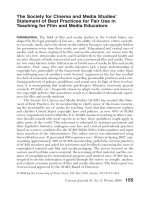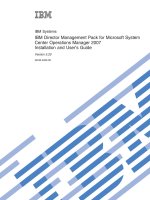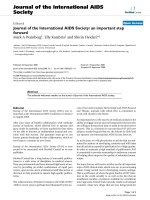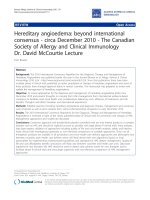RHETOR: JOURNAL OF THE CANADIAN SOCIETY FOR THE STUDY OF RHETORIC 2 (2007): DISSENT AND THE RHETORIC OF REFLECTION: BARBARA LEE’S SEPTEMBER 14, 2001, SPEECH
Bạn đang xem bản rút gọn của tài liệu. Xem và tải ngay bản đầy đủ của tài liệu tại đây (152.12 KB, 18 trang )
<span class="text_page_counter">Trang 1</span><div class="page_container" data-page="1">
<b>Dissent and the Rhetoric of Reflection: Barbara Lee’s September 14, 2001, Speech </b>
Grant C. Cos Rochester Institute of Technology H.H. Cooper has broadly defined terrorism as “the intentional generation of massive fear by human beings for the purpose of securing and maintaining control over other human beings” (881). This fear-for-control strategy was manifest in the acts of September 11, 2001, resonating powerfully among citizens and legislators throughout the world. Since September 11, terrorist acts throughout the world have doubled, occurring in such places as Madrid, Kirkuk, Tunisia, Bali, Mombasa, Riyadh, Istanbul, Casablanca, Jakarta, Sharm el Sheikh, and London. In the United States, the Bush administration’s initial response was a controlled military strike on the Taliban-run government of Afghanistan. In addition, the administration launched a wholesale military action against Iraq, toppling Saddam Hussein’s dictatorial reign.
However, the last three years have shown a slow devolution from what was considered a swift, surgically successful military action to a drawn-out, bloody quagmire in which the US and its few coalition supporters are finding it less possible to maintain basic societal stability, much less the installation and promotion of democracy. In an assessment of American anti-terrorism policy, Mark Danner argues that the rise in international acts of terrorism found its genesis in the tone and the attitude of the American response to September 11. Around the world and
increasingly in the United States, a growing concern over the US invasion of Iraq has initiated a much-needed debate about American foreign policy and its bearing upon war and peace and terrorism. The Bush administration has continually countered this criticism with calls for national unity and requests for other countries to aid in the Iraq mission.
In the early stages of conflict, John Murphy recognized the Bush administration’s ability
</div><span class="text_page_counter">Trang 2</span><div class="page_container" data-page="2">to control the war’s representation for the American people (607-32). Framing a coming struggle in apocalyptic terms, the Bush administration grounded the country’s problems on important cultural touchstones of manifest destiny and national redemption. Indeed, war declaration
rhetoric is a distinct area of presidential action and legitimation, usually recognized as one of the most important roles a US president can have (Campbell and Jamison; Ivie). This great request for war powers usually generates some opposition and dissent, however tepid. It is a cliché to state that dissent is a cornerstone of democracy and, more specifically, an essential element in the discussion of public issues. However, in this over-communicated and hyper-nationalized age, the case for full and contentious public deliberation on matters of war and peace, fully accepting a rhetoric of dissent, is absolutely essential. It calls for the application of the age-old notion of prudence to increasingly compressed and rushed public deliberation. Such a rhetorical act emerged from the heated discourse of the fall of 2001. The act was a speech by Democratic Congresswoman Barbara Lee.
Barbara Lee’s September 14, 2001, speech on the floor of the US House of
Representatives is remarkable as an example of what I call a “rhetoric of reflection.” The only member to vote against giving President George W. Bush open-ended war-making authority against the agents involved in the September 11 attacks, Lee gave a speech that was unique and brave and controversial. Her vote entered her into a small club of Congressional war dissenters such as Jeannette Rankin from Montana, Wayne Morse of Oregon, and Ernest Gruening of Alaska (Samuel 33). The speech garnered significant criticism in the press. For example,
<i>conservative San Francisco Chronicle columnist Debra Saunders compared Lee’s vote to </i>
European and American appeasement prior to World War II and labeled Lee’s action a
throwback to the “peacenik talk” of the Vietnam War era (qtd. in Nichols 29). However, even in
</div><span class="text_page_counter">Trang 3</span><div class="page_container" data-page="3">the face of stringent criticism and public shock, some recognized the significance of Lee’s act. Peter Carlson argued that, historical import and slander aside, Barbara Lee’s vote and speech were wholly pragmatic and recognized that “we’re grieving. We need to step back and think about this [military action] so that it doesn’t spiral out of control. We have to make sure we don’t make any mistakes” (C01).
The purpose of this essay will be to analyze Lee’s speech rhetorically, from a perspective that Carl Burgchardt identified as ethical criticism. Specifically, this essay will identify the “rhetoric of reflection” as a subset of a much larger (and older) area of prudential rhetoric. Drawing on the ideas of Edwin Black’s “second persona” and Lisa Ede and Andrea Lunsford’s “audience addressed/audience invoked,” this study examines the rhetorical means by which US Congresswoman Barbara Lee constructed a brief, prudential argument against granting the US president unlimited war powers. I will argue that the idea of a reflective rhetoric is both a surface level appeal and a deeper explication of a pragmatic public policy position.
Three important concepts drive this essay. The first is the idea of the constructed
audience. This idea evolves from the writings of Black, and Ede and Lunsford. Black’s notion of the “second persona” as a means to read and understand a world view is primary in this analysis. Black believes that the “implied auditor” of a discourse can determine the moral substance of that discourse. From this perspective, both the audience and its morality lie in the language of the speaker. Likewise, Ede and Lunsford’s notion of “audience invoked” is “a construction of the writer, a created fiction … The writer uses the semantic and syntactic resources of language to provide cues for the reader which help to define the role or roles the writer wishes the reader to adopt in responding to the text” (160). While both concepts posit a constructed audience, Black’s idea is focused on the moral dimension of language use. Ede and Lunsford provide more
</div><span class="text_page_counter">Trang 4</span><div class="page_container" data-page="4">resources for the social dimension of the persona of the created auditor.
The second guiding concept of this paper is the idea of the reflective “no.” Ray Fabrizio, Edith Karas, and Ruth Menmuir identify four “voices” in what they call the “rhetoric of no.” Of these four voices (an impassioned no; a discursive no; a reflective no; and an ironic no), it is the “reflective no” that is most significant in our present political climate. As Fabrizio, Karas and Menmuir note, whereas “[t]he impassioned writer reaches out to the reader principally with his feeling[,] the discursive writer reaches out to the reader with his subject, trusting him to perceive its validity. But unlike both of these, the reflective writer reaches out to his reader only
incidentally. His primary interest is in what his subject means to him” (249). The reflective writer or speaker is conversing with him- or herself. However, the authors note that the reflective dissenter is not unaware of the audience; rather, he or she is working out or thinking through the subject before an audience. A rhetor is “impelled to express himself even when he feels that what he is saying will cause no change in the world … his real purpose is to give outward expression to his inner thoughts and feelings” (Fabrizio, Karas, and Menmuir 249-50). This form of dissent rhetoric is highly personal and “intimate,” with the author “articulating his subject for its own sake” (250).
The third concept is Edwin Black’s “prism” metaphor. Using the prism to analyze Abraham Lincoln’s Gettysburg Address, Black noted that “its aspects reflect back and forth on one another in such radiant multiplicity that, diamond-like, its fires are somehow both protean and integral” (22). Following Black’s approach, the various reflections of style, argument, and ethical stance of the speech will be examined to determine how these many “facets” contribute to the reflective, prudential nature of Barbara Lee’s speech.
</div><span class="text_page_counter">Trang 5</span><div class="page_container" data-page="5"><b>Context </b>
<i><b>Vietnam Syndrome </b></i>
Caught up in the anger and emotion following September 11, few would have thought that the spectre of Vietnam, and what some had called the Vietnam Syndrome (Karnow; Simons), would reappear in public discourse and policy; yet given the many events of the last twenty-nine years, this spectre echoes in the words of US Representative Barbara Lee. Michael Klare defines the Vietnam Syndrome as “the American public’s disinclination to engage in further military interventions in internal Third World conflicts” (1). This disinclination is, as Klare states, “a prudent and beneficial alternative to the interventionist policies which led us into Vietnam in the first place” (1).
As Geoff Simons points out, various American administrations have pushed an
interventionist agenda for some years. These impulses were given voice at the time of the Persian Gulf War, captured in President George H. W. Bush’s statement that “we’ve finally licked the Vietnam Syndrome” (Simons 21). Within this statement lies the belief that the unwillingness of the American people to be the world’s police had subsided, and that the United States was more believable in its claims to use all the means necessary to support its international policy
initiatives. Lloyd Gardner goes further, observing in the Johnson administration’s contribution to the syndrome that
<small>Reducing the history of the Vietnam War to the abstractions ‘credibility’ and ‘reliability’ made it possible to deal with that history on terms established by the outcome of the Gulf War. But the end of the cold war raised more profound questions about how to interpret the Vietnam experience and the meaning of the ‘syndrome,’ questions others besides historians must ponder. (543) </small>
The central question raised by Lee’s speech is how history and collective memory shape war policy. The literature on public memory and US involvement in Vietnam is growing in rhetorical
</div><span class="text_page_counter">Trang 6</span><div class="page_container" data-page="6">studies. Blair, Jeppeson, and Pucci’s study of the Vietnam War Memorial, Hasian and Frank’s analysis of the Goldhagen debates, and Dionisopoulos and Goldzwig’s analysis of Vietnam revisionist rhetoric have all explored the link between the rhetorical function of remembering and history. The link between rhetoric, policy, and memory is profound in the connection a people find between an identity and shared history. The meaning-making function of the Vietnam experience is still valid and exists as a prudent reminder or warning not to make rash decisions about policy.
<b>Dissent and Public Memory </b>
John Murphy noted the difficulty that congressional dissenters had when attempting to argue against a presidential proposal for military action. Through an analysis of the anti-war discourse of Robert F. Kennedy and Sam Nunn, Murphy concludes that a congressional dissenter must use both deliberative and epideictic rhetorical strategies to combat a president’s calls for war. The dissenter is hard pressed to challenge a president’s authority to make epideictic appeals for the morality and appropriateness of war. Murphy finds that “the war rhetoric of the presidency has become an almost insurmountable obstacle to successful dissent” (76). Kendall Phillips argues that the role dissent plays in society is stunted by the dominance of consensus within public argument. This limits the individual rhetor’s ability to use rhetoric to create resistance.
The anti-interventionist position dissenters usually take is located on the periphery of public memory. More than history, it represents the “intersection of official and vernacular cultural expressions” (Bodnar 14). It speaks to the official interpretations and perspectives on war while simultaneously voicing the specialized interests that are part of the “official,” national whole, but that represent more diverse values. As John Bodnar observes, public memory is a
</div><span class="text_page_counter">Trang 7</span><div class="page_container" data-page="7">broad continuum of beliefs about a society’s past that help it understand its past, present, and future. More specifically, “It is fashioned ideally in a public sphere in which various parts of the social structure exchange views. The major focus of this communicative and cognitive process is not the past, however, but serious matters in the present such as the nature of power and the question of loyalty to both official and vernacular cultures” (14-15).
Public memory, particularly when it is used to shape public discussion, can also function as a constraint on dissenting views. Kathleen German finds that, to promote unity and public support for the Persian Gulf War in 1991, President Bush had to transcend the public memory of the Vietnam War. She argues that directive language served the purpose of framing and
providing an overarching justification for going to war against Iraq in 1991. Carolyn Marvin claims that patriotism in the United States is a complete religion. In Marvin’s conception, the nationalistic impulse in America has become sanctified and functions as a ritualistic set of memories to support. This impulse served as a strong justification for the Persian Gulf War and an equally strong one for current military efforts in Afghanistan and Iran. This syndrome is inherently connected to the first Persian Gulf conflict in 1990, under then-President George H.W. Bush. Jerry Lembecke asserts that a psychological, yet mythic, connection exists between the Vietnam War veteran’s disgraced return to the US and attitudes toward veterans of more recent military conflicts. He believes this served as a rationale for quelling dissent during the Persian Gulf War. Indeed, Stanley Karnow cites George H.W. Bush’s assertion that “By God, we’ve kicked the Vietnam syndrome once and for all” as an attempt to change the collective memory of the country. Karnow’s analysis notes that “his [Bush’s] deployment [of troops] had been
preceded by sharp divisions in both Congress and in American public opinion,” and that “the country was sober and uncertain as widespread doubt and anxiety tempered the manifestations of
</div><span class="text_page_counter">Trang 8</span><div class="page_container" data-page="8">patriotism” (15).
<b>Analysis of the Text </b>
<i><b>Arguments in the speech </b></i>
The introduction to Lee’s September 14 speech announces the sympathy she personally felt for those slain in the events of September 11, acknowledging that “only the most foolish or the most callous would not understand the grief that has gripped the American people and millions across the world” (par. 1). She mentions that the events of September 11 had left her to “rely on my moral compass, my conscience, and my God for direction,” and acknowledges that “our deepest fears haunt us now.” The significant thing about the introduction is that, while it acknowledges the fear, anger, and sadness of the events, it includes (as do other parts of the speech) a pivot phrase that asserts Lee’s main idea: “Yet I am convinced that military action will not prevent further acts of international terrorism against the United States” (par. 2). Based upon the three foundations of morality, individual conscience, and spirit, she asserts an anti-interventionist thesis.
Lee recognizes that the use of force resolution will pass, pointing out “we all know that the President can wage a war even without this resolution” (par. 4). She humbly urges the “use of restraint,” asking her fellow members of the House to think through their actions. With this statement, she constructs the first part of her argument—that an analysis of the long-term ends is essential to all the US does in the arena of foreign policy, particularly if that policy would engage war-making activity. This statement also serves as evidence of Lee’s reflective rhetoric. Much as Fabrizio, Karas, and Menmuir have argued, Lee “thinks through” her argument for her audience. However, this public demonstration serves as a counterpoint to those supporting the use of force resolution being debated. It is at this point of her speech that she approaches the heart of her
</div><span class="text_page_counter">Trang 9</span><div class="page_container" data-page="9">argument.
Lee makes four claims that serve as the main points of the message. First, she claims, “we are not dealing with a conventional war. We cannot respond in a conventional manner.” The many variables involved include “national security, foreign policy, public safety, intelligence gathering, economics, and murder” (par. 5). Second, she states, “we must not rush to judgment.” In the heat of emotion, she warns, the US may forget common decency and humanity in its acts and run the “risk that women, children, and other non-combatants will be caught in the crossfire” (par. 6). Third, she asserts that the US cannot “let [its] justified anger over these outrageous acts by vicious murderers inflame prejudice against all Arab-Americans, Muslims, Southeast Asians, or any other people because of their race, religion, or ethnicity” (par.7). Fourth, she warns that the US must “be careful not to embark on an open-ended war with neither an exit strategy nor a focused target. We cannot repeat past mistakes” (par. 8). Again, this last statement in this section of the speech serves as a pivot to move the listener/reader into a broader rationale, the heart of the anti-interventionist argument she is asserting. The heart of this argument is linked to public memory, the two tied together to prompt policy. This is clear when Lee remembers 1964, when “Congress gave President Lyndon Johnson the power to ‘take all necessary measures’ to repel attacks and prevent further aggression. In so doing, this House abandoned its own constitutional responsibilities and launched our country into years of undeclared war in Vietnam” (par. 9). Lee recognizes the problems of granting authority a blank cheque to take whatever action it deems necessary. She draws upon a touchstone of the Vietnam Syndrome reflected in both
interventionist (“take all necessary measures”) and anti-interventionist (“urge the use of
restraint”) perspectives. As Geoff Simons has suggested, the different world views “compete” for a dominant interpretation, where one view asserts the limitations and ethics of military power,
</div><span class="text_page_counter">Trang 10</span><div class="page_container" data-page="10">while the other considers the “suitability” of military power used prudently. Simons finds that “the Vietnam experience, like the Bible, could be read any way the readers chose” (25). He states that both visions have informed American foreign policy and that they both comprise the lessons America has learned from its experience in Vietnam.
Lee cites Senator Wayne Morse of Oregon, who was one of two US senators to vote against the Tonkin Gulf Resolution in 1964. Quoting Morse, she asserts, “I believe that history will record that we have made a grave mistake in subverting and circumventing the Constitution of the United States…. I believe that within the next century, future generations will look with dismay and great disappointment upon a Congress which is now about to make such a historic mistake” (par. 10). Her use of Morse’s words serves as a touchstone to the anti-interventionist perspective on sanctioning open-ended conflict. She underlines the point by stating that “Senator Morse was correct, and I fear we make the same mistake today. And I fear the consequences” (par. 11), taking a reflective stance toward the issue of war and the use of force. Her final call for reflection is found in her concluding statement. Again, in pain, Lee comes “to grips” with her controversial vote through the “very painful yet beautiful memorial service today at the National Cathedral.” Through the service, she claims to have found the courage to stand on principle, to stand for a moment of silence, of reflection. The final line of the speech proclaims her moral purpose. Quoting the “member of the clergy” speaking at the memorial service, Lee hopes that, “as we act, let us not become the evil that we deplore” (par. 12). This statement would briefly become a slogan for those opposing any rash, war-like solutions to the multi-faceted problem that was September 11. It would also be a lonely, muted, disregarded statement.
</div>








